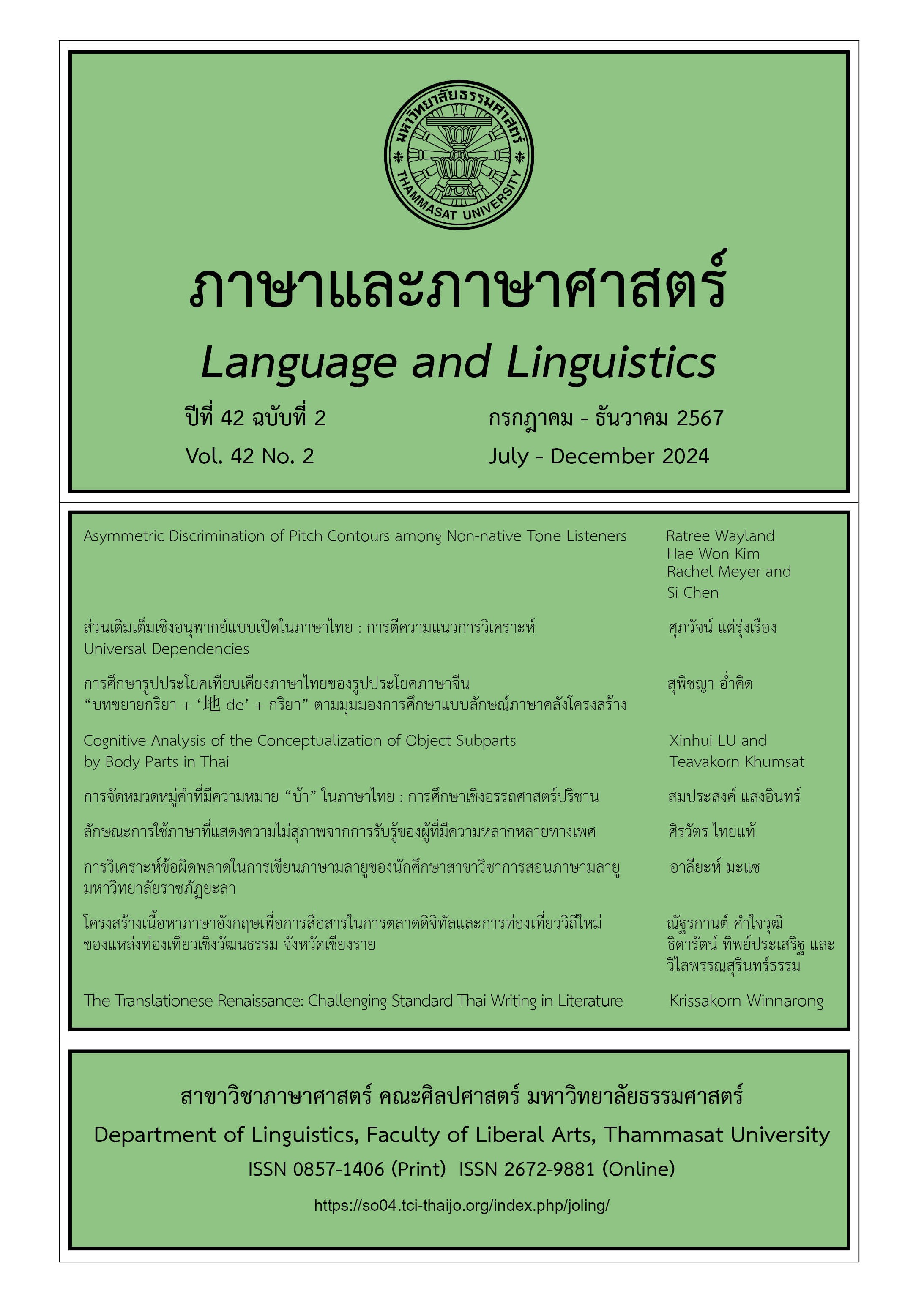Categorization of Words with the Meaning “Madness” in Thai: A Cognitive Semantics Analysis
Main Article Content
Abstract
This research aims to categorize 158 terms that mean “madness” in Thai and explain the conceptualization of its meaning. The findings show that the term encompasses 8 prototype semantic attributes: [human], [different], [damaged], [unaware], [obsession], [illness], [mental state], and [expression], with the prototype terms being “บ้า” /bâ:/ and “คลั่ง” /klâŋ/. Additionally, Thai expresses the meaning of “crazy” through two conceptual metaphor systems. The first system is metonymy, which includes [important organs], [crazy person’s behavior], [symptoms or diseases], and [treatment]. The second system is metaphor, which includes [superhuman or non-human], [leaky container], [damaged object], [incomplete object], [unawareness], [being consumed by a severe illness], [being possessed], [straying from the area or path], and [failing to reach a destination]
Article Details

This work is licensed under a Creative Commons Attribution-NonCommercial-NoDerivatives 4.0 International License.
บทความทุกบทความเป็นลิขสิทธิ์ของภาษาและภาษาศาสตร์
References
เคน เคย์. (2556). ทักษะแห่งศตวรรษที่ 21 สำคัญอย่างไร คืออะไร และจะทำสำเร็จได้อย่างไร. ใน เจมส์ เบลลันกา และ รอน แบรนต์ (บรรณาธิการ), ทักษะแห่งอนาคตใหม่ : การศึกษาเพื่อศตวรรษที่ 21 (พิมพ์ครั้งที่ 2) (น. 30-54). Openworlds.
โดม ไกรปกรณ. (2561). จิตเวชศาสตร์กับการสร้างอำนาจของรัฐบาลสยามในช่วงปลายทศวรรษ 2440 - ทศวรรษ 2460: ข้อเสนอเบื้องต้น. ใน มหาวิทยาลัยศรีนครินทรวิโรฒ, คณะสังคมศาสตร์, มหาวิทยาลัยเกษตรศาสตร์, คณะวิทยาการจัดการ, มหาวิทยาลัยศิลปากร, คณะอักษรศาสตร์, และ มหาวิทยาลัยราชภัฏนครปฐม, คณะมนุษยศาสตร์และสังคมศาสตร์, รายงานสืบเนื่องจากการประชุมวิชาการระดับชาติ SMARTS ครั้งที่ 8 (น. 438-450). ผู้แต่ง.
ธเนศ วงศ์ยานนาวา. (2557). ความไม่หลากหลายของความหลากหลายทางวัฒนธรรม(พิมพ์ครั้งที่ 2). สมมติ.
นันทนา วงษ์ไทย. (2562). อรรถศาสตร์ปริชานเบื้องต้น. เวิร์ค ออล พรินท์.
นววรรณ พันธุเมธา. (2544). คลังคำ. อมรินทร์.
พิชญ์สินี เสถียรธราดล และ อรทัย ชินอัครพงศ์. (2560). ความหมายเชิงมโนทัศน์ของคำว่า “โกง”ในภาษาไทย: การวิเคราะห์ตามแนวอรรถศาสตร์ปริชาน. วารสารมนุษยศาสตร์ มหาวิทยาลัยนเรศวร, 14(3), 105-119.
เพิ่มพูน สานิชวรรณกุล. (2560) . ประสบการณ์ทางจิตใจในระยะแรกของพ่อแม่หลังจากลูกได้รับการวินิจฉัยว่าเป็นเด็กที่มีความต้องการพิเศษ [วิทยานิพนธ์ปริญญามหาบัณฑิต, จุฬาลงกรณ์มหาวิทยาลัย]. Chulalongkorn University Intellectual Repository.
ยุกติ มุกดาวิจิตร. (2556). วิธีวิทยาศึกษาวัฒนธรรมต่อต้าน. ใน ยุกติ มุกดาวิจิตร(บรรณาธิการ), วัฒนธรรมต่อต้าน (พิมพ์ครั้งที่ 2, น. 3-56). ศูนย์มานุษยวิทยาสิรินธร (องค์การมหาชน).
สำนักงานราชบัณฑิตยสภา. (2554). พจนานุกรม ฉบับราชบัณฑิตยสถาน พ.ศ. 2554. https://dictionary.orst.go.th/
อัญชลี สิงห์น้อย วงศ์วัฒนา. (2563). ระบบคำเรียกชิ้นส่วนและอะไหล่รถยนต์ไทยในมุมมองภาษาศาสตร์ปริชาน. วารสารมนุษยศาสตร์ มหาวิทยาลัยนเรศวร, 17(3), 31-48.
ThaiHealth Official. (27 กุมภาพันธ์ 2561). เด็กออทิสติก เป็นอัจฉริยะจริงหรือ? สำนักงานกองทุนสนับสนุนการสร้างเสริมสุขภาพ (สสส.). https://www.thaihealth.or.th/เด็กออทิสติก-เป็นอัจฉร-2/
Ooca - อูก้า แอปฯจิตวิทยา. (13 มกราคม 2564). #เลิกเมกฟันกับโรคต่างๆ. [Image attatched] [Status update]. Facebook. https://www.facebook.com/oocaok/posts/1019643365105905/
Evans, V., & Green, M. (2006). Cognitive linguistics: An introduction. Edinburgh University Press.
Grady, E. J. (2007). Metaphor. In D. Geeraerts & H. Cuyckens (Eds.), The Oxford handbook of cognitive linguistics (pp. 188-213). Oxford University Press.
Kövecses, Z. (2010). Metaphor: A practical introduction (2nd ed.). Oxford University Press.
Lakoff, G. (1987). Women, Fire, and Dangerous Things. University of Chicago Press.
Lakoff, G. and Johnson, M. (1980) Metaphors We Live by. University of Chicago Press.
Panther, K., & Thornburg L. L. (2007). Metonymy. In D. Geeraerts & H. Cuyckens (Eds.), The Oxford handbook of cognitive linguistics (pp. 236-263). Oxford University Press.
Rosch, E., Mervis, C., Gray, W. D., & Johnson, D. M. (1976). Basic objects in natural categories. Cognitive Psychology, 8(3), 382-439.
Singnoi, U. (2006). Eating terms: What the category reveals about the Thai mind. Manusya: Journal of Humanities, 9(1), 82-109. https://doi.org/10.1163/26659077-00901006


